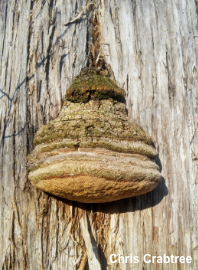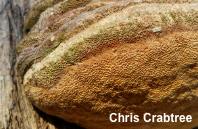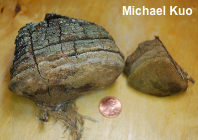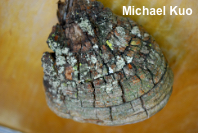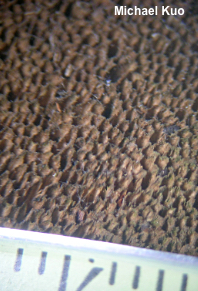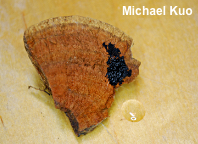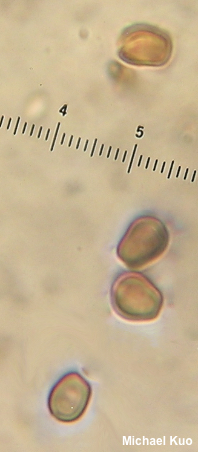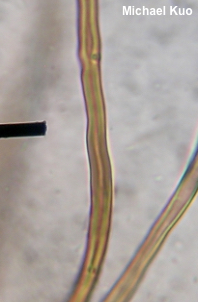| Major Groups > Polypores > Pyrofomes juniperinus |

|
Pyrofomes juniperinus [ Basidiomycota > Polyporales > Polyporaceae > Pyrofomes . . . ] by Michael Kuo Found on juniper trees across North America, this tough, hoof-shaped polypore is fairly easily recognized by the juniper habitat, the woody and bright orangish brown flesh that turns black in KOH, and the oddly shaped spores, which have slightly flattened sides, making them not quite ellipsoid. Pyrofomes juniperinus was called Pyrofomes demidoffii until recently, when Vlasák and collaborators (2017) determined that Pyrofomes demidoffii is a Eurasian species, and that our North American version differs in DNA and morphology. Pyrofomes juniperinus subspecies earlei is, according to Vlasák and collaborators (2017), limited to western North American junipers, and differs from the eastern subspecies in having a cracked cap surface, 2–3 pores per mm, and larger spores measuring 6–9 x 4.5–7 µm. However, the collection described and illustrated here, from Missouri on eastern redcedar, demonstrates a cracked cap, 2–3 pores per mm, and spores 5.5–7 x 4.5–5 µm, defying the correlations set out by Vlasák and collaborators. Thanks to Chris Crabtree for collecting, documenting, and preserving Pyrofomes juniperinus for study; his collections are deposited in The Herbarium of Michael Kuo. Polyporus juniperinus and Fomes juniperinus are synonyms. Description: Ecology: Saprobic and sometimes parasitic; growing alone or in groups on the wood of living or dead juniper trees (species of Juniperus); producing a white rot of sapwood and heartwood; perennial; widely distributed in North America, but more commonly found from the Rocky Mountains westward (subspecies earlei; see discussion above). The illustrated and described collection is from Missouri. Cap: 5–12 cm across; 5–8 cm tall; hoof-shaped or irregularly convex; with concentric grooves delineating each year's additional growth; woody and hard; grayish brown to dark brown; dry; developing cracks and fissures; sometimes hosting lichens. Pore Surface: Brownish buff when young, becoming dark brown with shades of orangish brown; bruising dark brown; with 2–3 angular pores per mm at maturity; tubes in annual layers 2–4 mm deep, yellowish brown (younger layers) to rusty brown (older layers). Stem: Absent. Flesh: Bright orangish brown; woody. Odor and Taste: Not distinctive. Chemical Reactions: KOH instantly black on flesh and tubes. Spore Print: Brown to orangish brown. Microscopic Features: Spores 5.5–7 x 4.5–5 µm; vaguely ellipsoid, but often with a truncated end and squarish sides; smooth; walls 0.5–1 µm thick; orangish brown in KOH. Cystidia and setae not found. Hyphal system dimitic; generative hyphae 2–3 µm wide, smooth, thin-walled, with clamp connections, hyaline in KOH; skeletal hyphae 2–6 µm wide, walls about 1 µm thick, smooth, orange-brown in KOH. REFERENCES: (H. Schrenk, 1900) Vlasák & Spirin, 2017. (Gilbertson & Ryvarden, 1986; Justo et al., 2017; Vlasák et al., 2017.) Herb. Kuo 03201702, 09191703. This site contains no information about the edibility or toxicity of mushrooms. |
© MushroomExpert.Com |
|
Cite this page as: Kuo, M. (2019, September). Pyrofomes juniperinus. Retrieved from the MushroomExpert.Com Web site: http://www.mushroomexpert.com/pyrofomes_juniperinus.html |
